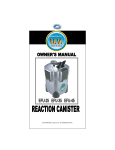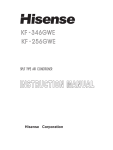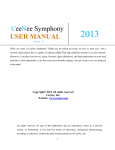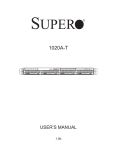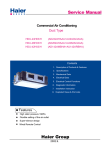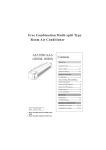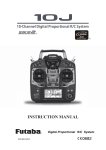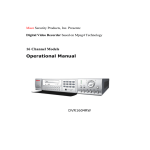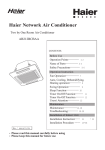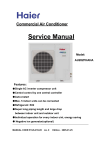Download Hisense Group KF-5002GWE User's Manual
Transcript
● Thank you for purchasing or distributing Hisense products. ● Please read this manual carefully before using the appliance. ● Please keep this manual in a safe place. ● Specifications may vary slightly to those indicated due to technical improvements. Contents 1. FEATURES 1 2. SAFETY NOTICE 2 3. COMPONENTS INTRODUCTION 5 4. OPERATION MANUAL 9 5. MAINTENANCE 15 6. WISE OPERATION 17 7. TROUBLE SHOOTING 18 8. TECHNICAL TABLES AND DIAGRAMS 21 APPENDIX: INSTALLATION 23 RZA-0-1000-908-SM-B Features Novel exterior Excellent selected material, compact structure, arc streamline, simple line, luxurious and elegant, novel design, representing international prevalent trend. Trouble shooting When it has fault, the microcomputer can self-diagnose and display the reason of the fault, convenient for m a i n t e n a n c e . Microcomputer controlled operation Internal microcomputer with powerful function, easy operation and use of remote control unit, air conditioner can automatically adjust the room temperature and humidity without troubling you, give you a pleasant enjoyment. Ultra-mute operation Excellent flue design, best angle for airflow intake and outlet, enable the airflow to be quiet and smooth with m i n i m u m n o i s e . Air freshing function Multi-photocatalyst comprehensive functions, effetely eliminate the soot, bacteria and peculiar smell in the indoor are, provide you with a green and healthy space. Night energy saving mode This function can automatically change the room temperature setting, providing you with comfortable environment, saving energy. Automatic adjustment of airflow speed and airflow direction The airflow of the indoor unit can be set to four modes of AUTO/HIGH/LOW/MUTE, and the airflow from the air conditioner can be blown to each corner of the room through changing the angle of the flap vanes. 12 -Hour ON and OFF Timer This Timer can be set to automatically turn the unit on or off at any time within a 12-hour period. 1 Safety ! ! Notice WARNING: Operations displaying this symbol may result in fatal injury. CAUTION: Operations displaying this symbol may result in serious injury. A. Instructions for installation B. Instructions for operation Do not sit directly in the cold air stream from the appliance, or set excessively low operation temperature. Installation only by authorized professionals through local distributors. Attention should be paid to power source, supply capacity, electrical wire or sockets. R Never install the appliance in an area near inflammable gas. Connect the appliance, using a separate cable and plug, to a dedicated socket with a capacity not less than 16A. Install a correctly rated circuit breaker. Don't insert articles into the air inlet and keep children away from the appliance. The appliance must be earthed. Never earth the appliance to a gas or water pipe, lighting rod or phone wire. Correctly install tubes to avoid water leakage. Use the correctly rated electrical cable and protect from damage or heat sources. 2 Safety Notice Avoid unnecessarily plugging and unplugging the appliance. Never operate the appliance with wet hand. Keep plants or pets away from the air source. Be sure that the power plug is clean and completely inserted to the socket. Do not clean the appliance by washing with water. Hold the plug, not the wire, when unplugging the appliance. The appliance must only be used for room air conditioning. Do not let the appliance under heavy load. 3 Safety Notice Keep the room well ventilated, especially in rooms where burners are used. Do not place other electrical appliance under the air conditioner. Disconnect the appliance when cleaning. Unplug the appliance when operation of the appliance stops. Make sure that fan stops before cleaning. Unplug the appliance in the event of abnormal operation and contact a distributor or the after-sales service for repair. Keep gas burners away from moving air from the appliance. Only qualified professionals should move the appliance for reinstallation. Contact the distributor or after-sales service for assistance. Unplug the appliance when operation is suspended for long periods. Only qualified professionals should repair the appliance. Contact the distributor or after-sales service for assistance. Regularly check the securing bolts and support rack of the outdoor unit. 4 Components Introduction INDOOR UNIT Air filter Air fresh filter Indoor unit sensor(inside) Switch button Front cover Air inlet Impeller (up-down adjustment) Air outlet Impeller (left-right adjustment) Power plug Display panel OUTDOOR UNIT Cable Tubes Air inlet (rear and side) Drainage hose Air outlet 5 Components Introduction INDOOR UNIT DISPLAY PANEL POWER HI-POWER TIMER OPERATING Each part stands for: 1. Power indicator illuminating means the appliance in operating condition. 2. Timer indicator illuminating means the appliance in timer or sleep condition. 3. Operating indicator illuminating means the compressor in work condition. 4. Hi-power indicator illuminating means the appliance in hi-power condition. INDOOR UNIT SWITCH PANEL Indoor unit switch panel is under the front cover, it can be used while remote control unit is bad or losing. ON/OFF 6 Components Introduction REMOTE CONTROL UNIT Transmitter Transmitting signals to the indoor unit, the symbol will appear on the top of LCD. Sensor Testing the ambient temperature of the remote control unit LCD Displaying the running condition. T.SETTING A C HOUR A ON Hi-power running button ON/OFF H.P. Sleep button Press the button, the appliance enter sleep mode. Flap Up-down adjustment Timer on/off button Setting the time of appliance on/off. Set/cancel timer button Set or cancel the time of appliance on/off. A OFF TEMP. On/Off button Press the button to run, press again to cease. Temperature setting button Press the button marked " "or " " to increase or decrease the temperature. Mode selection button SLEEP Auto Fan cooling MODE FLAP ON dehumidification OFF FAN/MUTE Fan speed selection button SET BATTERY CLR RESET SENSOR Reset button Press the button after batteries are loaded and indication appears on LCD. A/C sensor button Press the button if the remote control unit is liable to be affected by the heat resource, such as electric blanket, radiator or sunlight, this will use the sensor of indoor unit, the symbol will appear on the LCD. Sliding cover Battery compartment COMMONSENSE Remove the batteries in the remote control unit when it is not used for a long period. Replace the batteries when the indication on the LCD of the remote control unit is faint, or the remote control unit cannot be set or operated. Properly dispose of used batteries. Keep the remote control unit away from cold or hot air, sunlight or heat sources. Contact the local distributor if the receiver in the appliance does not work in a room illuminated by fluorescent tubes. Remote control unit must be used within its effective range or the timer and the temperature control will not function properly. Control will fail if two of the same model appliances are installed in the same room. If the remote control unit is fixed on the wall, press the On/Off button to ensure that the appliance is receiving a signal from the device. 7 Components Introduction HOW TO USE REMOTE CONTROL UNIT Install the battery A T.SETTING C 2 RESET button A 3 A Sliding cover 1 1. Press the two sides of the cover of the battery component and slide it downward and remove. After replacement of batteries, the LCD on the remote control unit will display the status. 2. Insert two AAA #7 Alkali batteries, and make sure that, The anode (+) and cathode (-) are properly placed. Do not use Manganese batteries. 3. Press the Reset button with a pointed tool and then replace the cover. COMMONSENSE Please make the remote control unit transmitter aim at the receiver of indoor unit. There shouldn't have any obstacle between the remote control unit transmitter and the receiver of indoor unit. Don't throw and break the remote control unit. 8 Operation Manual PREPARATION BEFORE RUNNING Raise the front cover, and then install the air filter. MANUAL OPERATION (COOLING, DEHUMIDIFICATION, FAN) Basic operation 1.Before running the appliance, press the "MODE" for selection one mode of the dehumidification, cooling and fan. 2.Press the "ON/OFF" button to start the appliance. 3.Press the "TEMP." button to set the temperature you wish. T.SETTING C 2 ON/OFF H.P. TEMP. 3 COMMONSENSE SLEEP ●A certain period of time is required to reach the desired temperature since the air of room cycles all the time. ● When appliance works in cooling and dehumidification MODE FLAP mode, if blocked by accumulated water drops, then air 1 ON SET BATTERY OFF filter should be cleaned and air fresh filter should be FAN/MUTE cleaned or replaced. CLR SENSOR RESET 9 Operation Manual AUTO RUN Basic operation 1. Press the "MODE" button for selection of the "AUTO" function for automatic cessation of the appliance. 2. Press the "ON/OFF" button and the appliance is then set in automatic mode. ON/OFF A T.SETTING C T.SETTING C A A 2 Illuminating ON/OFF H.P. TEMP. 3 POWER SLEEP HI-POWER TIMER OPERATING MODE FLAP 1 ON SET BATTERY OFF FAN/MUTE Press again the "ON/OFF" button to cease the operation of the appliance. CLR SENSOR RESET 3. Temperature Setting Each press of the "TEMP." will result in a temperature o adjustment of 1 C. A few seconds later, the room temperature will be displayed on the LCD of remote control unit. A T.SETTING C NOTICE: The appliance is designed to control the function of A operating mode automaticly, as well as airflow and air A direction, according to the temperature in the room detected by the appliance or the setting. A time lapse of a A T.SETTING A C few seconds will occur before alteration of airflow. 10 C A A A A Operation Manual FAN SPEED AND DIRECTION ADJUSTMENT Basic operation When the appliance works, press "FAN/MUTE" change airflow speed. Press "FAN/MUTE" each time, indoor unit fan speed can be altered among A , , , . When the appliance works, press "FLAP" change vertical airflow direction. T.SETTING C Press "FLAP" each time, fan impeller will appears the following in turn: FLAP 6 5 4 3 2 1 1. Vertical airflow adjustment Fan auto mode: fan impeller sways between 6 and 3 in cooling and ON/OFF H.P. TEMP. dehumidification mode. Fan sweep mode: fan impeller sways from top and bottom. SLEEP 2.Horizontal airflow adjustment Adjust horizontal airflow by pushing the left-right fan impeller with hands. MODE FLAP ON SET BATTERY OFF FAN/MUTE CLR SENSOR RESET Left-right airflow fan impeller When the appliance works in dehumidification mode, fan speed is low and can not be altered. The remote control unit can be used to adjust the air direction. Manual adjustment may result in conflict between the actual position and the desired position by the remote control unit. Turn off the appliance with the remote control unit and restart the appliance after the fan imperller is completely closed. Water drops may accumulate around the air inlet if the appliance is operated for cooling in humid seasons or for dehumidifying. Adjust the fan imperller correctly. Never attempt to touch the rotating fan impeller for whatever reason. 11 Operation Manual TIMER SWITCH ON/OFF Postponed Start Setting The appliance will start operating after the period set by the timer. When the appliance is set in the "Cooling" mode, a desired temperature will be reached after a desired set time (the reservation function). T.SETTING C Postponed cessation setting Set the time for cessation of the appliance, the appliance will then stop operating upon expiry of the set period. ON/OFF H.P. TEMP. SLEEP MODE FLAP ON OFF SET BATTERY FAN/MUTE CLR SENSOR RESET 1. Press the "ON / OFF " button. Each press will alter the hour indication by one. Maximum number is 12. A C For example: If you wish the appliance start three hours later. The timer switch illuminates when the timer is set. T.SETTING HOUR ON A T.SETTING C For example: If you wish the appliance stop one hour later. illuminating HOUR A OFF POWER TIMER HI-POWER OPERATING 2. Press the "SET" button to confirm the time setting. Press the "CLR" button to inactivate the time setting. 12 A Operation Manual SLEEP SETTING MODE/HI-POWER OPERATION/AIR FRESHING Sleep Setting Mode This mode can be manually set to save energy while maintaining a desired well conditioned atmosphere at night. T.SETTING C Press the "SLEEP" button during dehumidifying and cooling. T.SETTING C ON/OFF H.P. TEMP. SLEEP A A MODE FLAP ON SET BATTERY OFF Cancellation of "SLEEP" Press the "SLEEP" button once. FAN/MUTE CLR SENSOR RESET Air freshing When appliance works, the air fresh filter of indoor unit can effectively filter, absorb and decompose harmful ingredient. Hi-power operation The appliance set in this mode will produce lower temperature air than ordinary condition. This function can make you feel comfortable rapidly in summer. Press "H.P." button, the appliance start to work in this mode. Press "H.P." button again, to cancel this mode. EMERGENCY OPERATION Open the front cover, the switch panel can be found. Press the "ON/OFF" button to start the appliance, and in this condition the appliance will automatically select operating mode in terms of indoor temperature. Press the "ON/OFF" button again to cease the appliance. NOTICE: The operation can be only used while remote control unit is bad or losing. Moreover, don't often press the button. 13 Maintenance ! CAUTION Cuts and abrasions may result from contact with the sharp components inside the appliance. Clean the air filter once very two weeks. 3. Cleaning the air filter 1. Cleaning of indoor unit Wipe the indoor unit with a dry soft cloth damped in 40℃ water. Raise the front cover and take out the air filter. 2. Front cover cleaning After cleaning the dirt of the air filter, please wash the air filter by water then dry it. In terms of the operation shown as picture, unload the front cover. 2 1 Wipe and dry the front cover with a sponge or similar substance. Mild detergent can be used for excessive dirt. Install the air filter and hold both sides of the front cover as shown by the arrows. In terms of the operation shown as picture, load the front cover. 14 Maintenance 4. Cleaning and replacement of air fresh filter Raise the front cover and take out the air filter. 5. Long-term cessation Warm and air the inside to dry the appliance. B efore unplug the appliance for cessation of operation, press "ON/OFF" button to cease the appliance, then pull out the power plug. Take out the dirty air fresh filter from the air filter. There are two kinds of air fresh filter, the photocatalyst health filter can be used again after washed by water and dried; the electrocstatic air cleaning filter should be replaced with a new one. Cl ean the air filter and take out the air fresh filter. Install the air fresh filter onto the air filter and close the front cover as shown by the arrows. Remove the batteries from the remote control unit. 15 Wise Operation Blockage of the air inlet or outlet may reduce the cooling capacity of the appliance. Excessively low temperature setting may be harmful to health and will result in high power consumption. Cooling capacity can be reduced by accumulated dirt on the air filter. Clean the air filter when noise is heard or water drops accumulate at the outlet. Make sure windows and doors are properly closed. Draft strips are recommended for use in summer . Window blind reduces 15% of sunlight and window strips reduce 50%. Adjust the wind direction to level for cooling. Please use the timer reasonably to save consumption. Properly set the temperature. When setting for cooling, the most desirable difference between inside and outside temperature is 5℃ . 1℃ increase of the set temperature will save 10% of power consumption. 16 Trouble Shooting Strange odor Odors from wall carpet or clothing will be absorbed and transmitted by the appliance. Failure of airflow conversion Airflow cannot be altered when the dehumidification are started. Sound of water flow From circulating refrigerant inside. Postponed operation The safety function postpones 3 or 5 minutes before operation after the appliance is connected to the power supply. Strange sound Caused by shrinkage due to coldness. Wait a minute Ka 17 da Trouble Shooting Make sure any of the following circumstances occurs: Failure of Operation Failure of Desired Cooling Capacity Sleep mode for energy-saving Excessive people in the room Power failure Operation of the appliance will be recovered after failure of power supply. Door or window are not closed. Power is disconnected Low fan speed is set. Short circuit or blown fuse Temperature is set too high for cooling. Signal from the remote control unit is out of reach of the indoor unit receiver. Batteries in the remote control unit are exhausted or incorrectly inserted. Air filter is blocked by dirt. The button "RESET" is not pressed. Excessive storage around the outdoor unit. 18 Trouble Shooting Contact the after-sales service for repair should any of the following events occur (see the Warranty Card). Strange sound Burned smell Water leakage from indoor unit Hot power plug Blown fuse or circuit breaker trip Loosed or corroded support rack Additional Information Unplug the appliance for any of the following: After a long period of operation, the safety device Long term cessation starts, and sometimes the appliance cannot be Lighting and thundering weather operated. Maintenance Water drops may accumulate on the surface of the Suspicious problem appliance in a rainy screen or a long period of cooling or dehumidification The appliance must be used in a proper area as Voltage abnormal protection regulated. Operation of the appliance will cease when The air filter must be regularly cleaned to prevent abnormal voltages are encountered. water accumulation caused by dirt blockage. Desired temperature may not be reached for restriction of ambient temperature or blockage of the air filter . 19 Technical Tables and Diagrams O 1. PERMITTED AMBIENT TEMPERATURE FOR THE AIR CONDITIONER IS AS FOLLOWING: +18~+43 C(GB/T 7725-1996). 2. MAIN SPECIFICATIONS OF THE PRODUCT Model KF-5002GWE Rated voltage AC, Voltage range 220V Rated frequency 50Hz Rated input power cooling Capacity 220V-230V 1.92kW ~ 5.0kW cooling 3 Circular airflow(high) 750m /h 3 Refrigerant/quantity R22/1.85kg Weight (indoor unit/outdoor unit) 13.0kg/54.0kg 。 8m/80 Max. Remote control distance/angle range 3. REFRIGERANT FLOW DIAGRAM Indoor unit Outdoor unit Wide service valve Compressor Accumulator Heat exchanger Heat exchanger Wide tube O.D.12.7 Narrow tube O.D.6.35 Narrow service tube Caplillary 20 Filter Cooling cycle Technical Tables and Diagrams 4. ELECTRICAL WIRING DIAGRAM INDOOR UNIT YEL/GRN EVAPORATOR POWER SOCKET YEL/GRN BRN SENSOR POWER TRAN. BLU TERMINAL PANEL 0 BRN CONECTION WITH OUTDOOR UNIT SENSOR 1 2 3 RED 4 BLU 5 BLK BLK BLK BLK 2 1 2 1 1 1 1 2 SEC 1 2 WHT WHT 1 2 COM CM FLAP1 1 2 3 4 5 1 2 3 4 5 RED ORG YEL PUR BLU STEP MOTOR FLAP2 1 2 3 4 5 1 2 3 4 5 RED ORG YEL PUR BLU STEP MOTOR CONTROL BOARD PRY 1 2 SU ROOM COIL SW 1 1 1 2 FM PULSE IN 71 71 ~ ~ 31 3 1 3 3 5 5 BLU RED YEL SWITCH PANEL 2 2 BRN 1 2 BLK BRN BRN WHT COIL 2 2 DISPLAY PANEL FAN MOTOR OUTDOOR UNIT TERMINAL PANEL CONECTION WITH INDOOR UNIT 1 YEL/GRN 2 3 4 5 BLK WHT RED GRY CAPACITOR PNK WHT CAPACITOR BLK WHT R BRN C S FAN MOTOR COMPRESSOR YEL/GRN YEL/GRN 21 Appendix: Installation 1. SUMMARY 1.1 Notice This operation manual has explicit information for installation and maintenance in most conditions. Contact the local distributor or after-sales service for further information. 1) Wiring notice Only qualified professionals should carry out wiring of the appliance. Disconnect the power supply before completion of wiring, piping or checking the appliance. Voltages generated by the appliance is fatal. Read the electrical schematic diagram and explanation before installation. Improper installation and earth connection may result in fatal injury. C onnect the earth as required by local regulations. Tightly fasten all the wiring connections to prevent overheating or fire. Special power, switches and sockets are required for the power supply of the appliance. Electric meter capacity must be larger than or equivalent to 16A. Remark per EMC Directive 89/336/EEC To prevent flicker impression during the start of the compressor (Technical Process) and the adversely influence caused by the 2nd harmonics of compressor following installation conditions do apply 1. The power connection for the air conditioner has to be done at the main power distribution. This distribution has to be of a low impedance is reached at 32A fusing point. 2. No other equipment has to be connected to this power line. 3. For the detailed installation acceptance please refer to your contract with the power supplier, if restrictions do apply for products like washing machines, air conditioners or electrical ovens. 4. For the details of the power of air conditioner, please refer to the rating plate of the product. 5. For any question contact your local dealer. 2). Transport C arefully move the outdoor unit. 3). Installation ----When the appliance is mounted to the ceiling or the wall, Make sure that the ceiling or the wall is strong enough for the appliance. Make a wood or metal frame to support the appliance if necessary. ----When the appliance is mounted in a room, Properly insulate the outdoor unit, and make sure there is no moisture on the appliance or on the floor. ----When the appliance is installed on a damp or uneven area, Make a flat concrete base and place the base under the outdoor unit. ----When the appliance is installed in an area of strong winds. Using firm bolts and metal frames to fix the properly covered outdoor unit. ----When the appliance (Model Heat Pump) is installed in an area of heavy snow. The outdoor unit must be installed in a position above the snow accumulation. 4). Connection Use the shortest tubes possible Using a flaring method Smear some refrigeration oil between the flared surface and the connected tube. Fasten the nuts with a torque wrench to prevent leakage of refrigerant. Check for leakage before trial operation. 5). Maintenance Disconnect the power before checking the electrical components and the circuits. Avoid contact with the moving parts of the appliance. Clea r the site and make sure there is no installation debris left in the appliance. 6). Other Keep the room well ventilated during installation. 1.2 Installing instruction Read the operation manual before installation and keep this manual in a safe place. 1)Tools 1. Screwdriver 2. Phillips head screwdriver 3. Knife or wire stripper 4. Steel ruler 5. Spirit level 6. Hammer 7. Percussion drill 8. Tube cutter 9. Pipe flarer 10. Pipe bender 11. Adjustable spanner 2) Attachment (see the packing list) 3) Parts Package Copper tubes, components and insulation materials for the outdoor unit. 4) Type of the copper tube and insulation materials 1. Table 1 indicates that tubes should be cut with an additional length of 30cm-40cm, to reduce the vibration from the outdoor unit. ITEM KF-5002GWE Narrow tube Outside Diameter 6.35mm Wide tube Thickness 0.8mm Outside Diameter Thickness 12.7mm 0.8mm 2. The insulation materials for the copper tubes should conform to the required length and the wall thickness should not be less than 8mm. 3. Insulated copper wires should be used for wiring and the specification should depend on the length. 5) Additional materials for installation 1. white tape 2. nails or clips (as required) 3. putty 4. refrigeration oil 5. clips for fixing refrigerant tubes 22 Appendix: Installation 2. INSTALLATION LOCATION 2.1 Indoor unit ! 2.2 Outdoor unit Maintain the required space The outdoor unit should be installed away from the following: Heat source and fan exhausting (Figure 3); Director sunlight; WARNING around the appliance to prevent overheat. The location for installation of the appliance should not be in an area with the following: Di rect sunlight H eat resource Inflammable gas Thick oil fog The appliance should be installed in an area, Where the inside space can be evenly conditioned, or Which is strong enough for the appliance, or, Having the shortest distance for the copper tubes and water drain hose, and Having desired space around the appliance for maintenance and ventilation.(Figure 1) 8 Figure 3 The outdoor unit should be installed in an area with, Cool temperature; Good ventilation; Desired space for air inlet, outlet and maintenance (Figure 4) Min. 5cm Min. 5cm Min. 5cm Top obstacle Figure 1 15 H Added Refrigerant (g/m) 7 Valve side Min. 25cm Provided Tube(M) 20 Min. 10cm Air outlet 2m 2m Obstacle L Min. 10cm Air outlet Air inlet Tube arrangement Min. 40cm 4 L: Maximum length of the tube connecting the indoor unit and the outdoor unit. H: The height difference between the indoor unit and the outdoor unit. Figure 4 Ground Min.10cm Air inlet 2 Strong base (10x10cm concrete or alike). The appliance should be placed not less than 10cm high (Figure 5). Tube length(L) Indoor unit Firm bolts(4) Height difference(H) Outdoor unit Air inlet Min. 10cm Concrete or alike Figure 2 Ab * If the length of the tube is exceed 7m, an additional 20g/m of refrigerant should be added per 1m. ! WARNING ou t4 0c Abou t 10c m m Fix the base with firm bolts to reduce vibration and noise. The indoor unit should not be installed below a height of 1.8m. 23 Appendix: Installation 3. INSTALLATION OF INDOOR UNIT 3.1 Take off the back cover 1) Release the clips as shown by the mark " " on the back cover. 2) Take off the back cover. 2) Unload the bottom cover of indoor unit with flat screw driver, and according to direction of lining tube, leave the cutting part of left bottom or right bottom cover with saw.(figure 10) 3.2Drilling 1) Locate the back cover of the indoor unit on the wall, and determine the desired place with a spirit level and a ruler. Before drilling, do not fix the back cover onto the wall. 2) According to direction of the tube ,drilling for tubes according to the location of the appliance. It is recommended that the rear right be used for wiring and drilling. 3) Drill a 65mm hole in the wall (Figure 6), make sure the hole is inclining to the outside . Indoor Cutting part Figure 10 Outdoor 3) Bind the electrical cable drainage hose, refrigerant tube, air exchange tube together tightly with white adhesive tape; the electrical cable, refrigerant tube and the electrical cable are fixed on the back of indoor unit with wedged slab, bend the refrigeration tube and make the electrical cable and the air exchange tube through hole of the wall smoothly(figure 11). Figure 6 ! CAUTION Before drilling, make sure that there is no electric cable or pipe in the area of the wall where the hole is to be drilled. Lining cover 3.3 Installation of the back cover 1) check with a spirit level that the back cover is installed horizontally. (Figure 7) Back cover Refrigerant tube Electrical cable Figure 7 Air exchange tube Figure 11 2) fix the back cover to the wall with the screws provided. (Figure 8). Make sure that the back cover is firmly fixed to he wall. 4) Install the dismantled bottom cover to indoor unit(figure 12). Figure 8 B 3.4 Install the indoor unit 1) Thread the cable through the hole in the wall, an additional 13cm of slack power cable should remain inside the room. (Figure 9) A C Figure 12 5) Adjust the position of the indoor unit, fixing it firmly onto the back cover(figure 13). Back cover Lining cover Electrical cable 13cm Figure 9 Figure 13 24 Appendix: Installation 3.6 Wiring connection of the indoor unit 3.5 Wiring (1)Before wiring, make sure the rated voltage indicated on the 1) Hold pull and open the front cover. nameplate conforms to the local power voltage. 2) Release the screws and open the wire distribution cover (2)Wiring should be carried out in accordance with the (Figure 15). instructions on the electrical schematic diagram (Figure 14). Terminal Panel of the indoor unit Terminal Panel of the outdoor unit 1 1 Wiring distribution cover Figure 15 2 2 3 3 3) Connecting cable should be placed along the back of the indoor unit to the front for connection. 4)Connect the wire distribution terminals and corresponding terminals .(Figure 16) Figure 14 ! WARNING Wi ring for connection of the indoor unit and the outdoor unit should be conducted in accordance with local regulations. Wiring connections must be fitted firmly. The electrical wires should not be in contact with any of the refrigeration tubes, compressor or other moving parts or components. The appliance must be connected to a good earth. Figure 16 5) Check the connections and then fasten the distribution cover and replace the front cover finally. 4. INSTALLATION OF THE OUTDOOR UNIT Properly locate the outdoor unit as described by the Section 2. If the outdoor unit is to be mounted on the wall ,make sure that the wall and the support are strong enough for the appliance. Wiring Connection 1) Release the fixing screws and take off the side cover. 2) Connect the terminals on the heap pump as required in the Figure 14 and the Figure 17: 3) Always save an extra 10cm length of the electrical cable: 4) Earth the appliance according to related regulations of electrical engineering: 5) Fix the connected terminals with clips and replace the side cover if the connection is assured according to the wiring diagram: Wiring distribution cover Figure 17 25 Appendix: Installation 5.REFRIGERANT TUBE 5.1 Flaring the tube (1) Cut the tube with a tube cutter to the desired length (30.50cm is recommended) (2) Smooth the edge of the copper tube with a reamer or a file. Hold the pipe vertically with one end downward to make sure that no copper scraps fall into the copper tube. 5.3 Heat insulation of the refrigerant tube All refrigerant tubes must be insulated heat with at least 8mm thick insulation materials. (Figure 22) Heat insulation materials Thickness of 8mm Min. 8mm Copper tube After Before Figure 22 5.4 Wrapping the tubes (1) Tie the two refrigeration tubes (including electrical wire if permitted as regulated), water drainage hose with white tape. (2) Wrap half of the tubes outside the room starting from the end. (Figure 23) Reamer Figure 18a Figure 18b (3) Put the tube flarer on the copper tube. (4) Flare the copper tube ( Figure 19) Clip Tapered nuts Copper tube Covering tubes with heat insulation materials Flarer Figure 19 Figure 23 Note: The flared tube should have: Smo oth internal surface Smooth edges C onsistent length of the tapered surface 5.2 Connection of the tubes (1) The sealing tube must be used to prevent dust or water from getting into the tube. (2) Before connecting the tube, apply some refrigerant oil on the surface of the flared tube and connections to prevent air leakage.( Figure 20) (3) Align the connecting tube and the flared tube, and then turn the tapered nut to connect tightly. (Figure 21) Application of refrigerant oil Connecting tube (3) Fix the wrapped tubes on the wall in clips with a space of 120cm. Note: Do not tie the tubes too tight as this may reduce heat insulation. Separate water drainage hose and refrigeration tubes to prevent formation of water droplets. 5.5 Ending of installation After completion of wrapping and insulation, seal the hole on the wall with a suitable sealant. 5.6 Discharge gas Place appliance A and then B. Air purging method is as follows: (1) Turn down the nuts on the wide and narrow tubes. (2) Loose the nut of the flared wide tube one complete turn with a spanner. (3) Turn counterclockwise to open the core of the valve with a socket screw wrench. Some gas will come out from under the nut of the flared end of the wide tube. Tighten the nut 10 to 15 seconds later. (4) Test for leakage at the tube connector with soapy water or a meter. If there is no leakage, turn counterclockwise to open the tube core of the valve on the wide tube with a socket screw wrench. (5) Tighten the nuts on the wide , narrow tube valves and the valve cover. Flared tube Figure 21 (4) Fasten the nuts with a spanner. Please contact the technical service for further information. 26





























